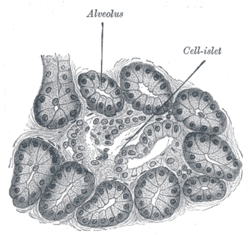Loading AI tools
From Wikipedia, the free encyclopedia
Alveolar glands, also called saccular glands, are glands with a saclike secretory portion, in contrast with tubular glands. They typically have an enlarged lumen (cavity), hence the name: they have a shape similar to alveoli, the very small air sacs in the lungs.
| Alveolar gland | |
|---|---|
 Section of pancreas of dog. X 250. | |
| Identifiers | |
| TH | H2.00.02.0.03028 |
| Anatomical terminology | |
Some sources draw a clear distinction between acinar and alveolar glands, based upon the size of the lumen.[1] A further complication in the case of the alveolar glands may occur in the form of still smaller saccular diverticuli growing out from the main sacculi.
The term "racemose gland"[2] is used to describe a "compound alveolar gland" or "compound acinar gland."[3]
Branched alveolar glands are classified as follows:
| Type | Description | Location | |
|---|---|---|---|
 |
simple branched acinar |
thyroid glands | |
 |
tubuloalveolar or tubulo-alveolar or tubulo-acinar or compound tubulo-acinar or compound tubuloalveolar[4] |
glands that start out as simple branched tubular, and branch further to terminate in alveoli | salivary glands,[5] esophagus[6] mammary glands |
Seamless Wikipedia browsing. On steroids.
Every time you click a link to Wikipedia, Wiktionary or Wikiquote in your browser's search results, it will show the modern Wikiwand interface.
Wikiwand extension is a five stars, simple, with minimum permission required to keep your browsing private, safe and transparent.